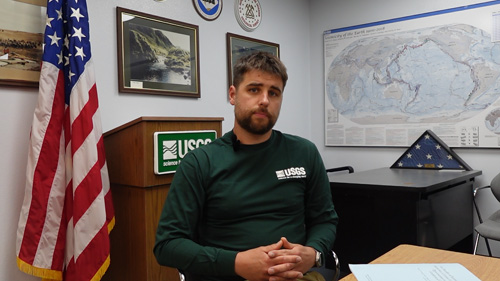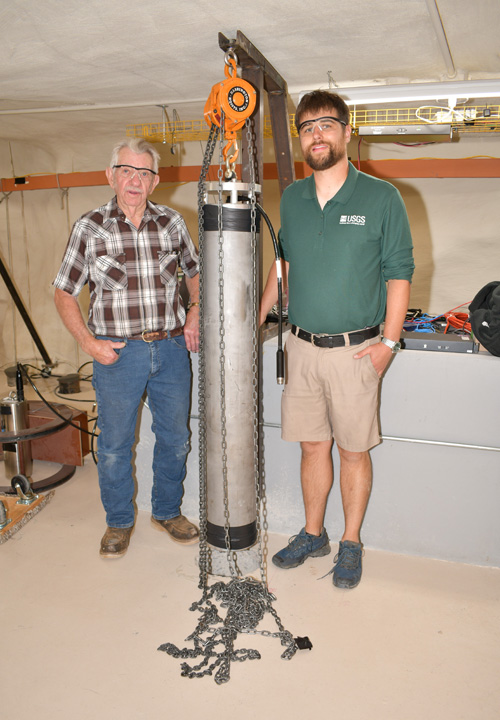18 August 2025—There’s a lot of things that Rob Anthony likes about New Mexico. But as a geophysicist interested in noise, there’s one aspect that stands out: the relative seismic quietness.
“We’re one of the quietest spots in the United States,” Anthony says of his workplace at the Albuquerque Seismological Laboratory. “And that’s mainly because we’re in 1.6 billion-year-old granite and we’re far from the ocean. So it’s a good place to test instrumentation and installation methodologies.”
Anthony’s research focuses on characterizing sources of seismic noise, particularly noise sources that aren’t earthquakes, and using that noise to understand earth surface processes, evaluate seismic instrumentation, and improve data quality for earthquake monitoring. These noise sources include microseisms, the natural and constant ground “hum” produced by the oceans and large lakes.
“The largest source of seismic energy in absence of earthquakes are going to be ocean waves. And they generate ground vibrations through two mechanisms,” says Anthony. The primary microseism comes from ocean waves transferring energy directly to a coastline, he explains, while secondary microseisms, about 1000 times larger in power, come from ocean waves interacting with each other and pumping the seafloor.
Anthony has used microseism data and other noise source data to characterize the seismic noise environment and changes in sea ice concentration and stability in Antarctica, decadal changes in global wave power and storms, to identify signals from the Great Lakes that could compromise earthquake observations, and determine discharge and flow in Colorado streams, among other projects.

The focus on noise feeds into Anthony’s other specialty, which is building and testing seismic instrumentation and installing seismometers. “Another thing I have been interested in is how do we shield against these noise sources, so we can make the observations for earthquake monitoring better?” he says.
“Although we can’t get away from microseisms very easily, we can mitigate the effects of atmospheric pressure changes showing up in seismic data. To this, we ideally need to place the seismometers at a depth of around 100 meters in a material with high rigidity, such as bedrock,” he adds. “However, logistically, this isn’t always feasible at every location we want ground motion observations, so we must evaluate tradeoffs to achieve the best performance given budget and other constraints.”
At ASL, Anthony installs experimental arrays, tests out the capacity of inexpensive seismometers and new types of batteries, and performs exploratory testing to improve the Global Seismographic Network—about two-thirds of GSN’s stations are run out of ASL.
His biggest project yet is almost ready to launch: a pressure vessel to put a seismometer down into the Antarctic ice at the geographic South Pole as part of the IceCube Neutrino Observatory. The seismometer is scheduled to be deployed this December.
“It would be at 2.4 kilometers depth, so about a mile and a half down through the ice,” Anthony explains. “This would be about, by an order of magnitude, the deepest borehole broadband seismometer on the planet.”
There are “immense challenges” to designing and deploying a seismometer in such a harsh environment, he says. Almost like a seismometer sent to the bottom of the sea, the IceCube seismometer must withstand both the enormous pressures of being lowered into a mile and a half deep hole drilled in ice, along with extra pressure as the resulting water column freezes.
“IceCube has previously observed pressure transients up to about 10,000 psi [pounds per square inch] before you get this kind of champagne cork effect where you pop out the ice plug above it and pressure drops,” Anthony notes.
Then there are all the other adjustments that need to be made for the seismometer to communicate from a depth with no Ethernet and no GPS signal. “Everything, the only lifeline for this device to the surface, is two conductors, just a twisted pair of wire,” he says.

What are the advantages of placing a seismometer at the pole? “When the Earth rings like a bell following large earthquakes … by analyzing the frequencies at which the bell rings, you can kind of understand the composition of the deep interior of the planet,” Anthony explains. “But because the ‘bell’ is spinning, at most seismic stations these frequencies get distorted by Earth’s rotational effects. But if you’re right at the South Pole, you don’t have this rotation distortion.”
The five-year IceCube effort has been “a dream and a nightmare project” for Anthony, as he and his team have been through the ups and downs of funding and technical challenges. It’s his first project leading a big team, “and I’ve had to count on other people’s expertise to ensure the success of the project, which was something that’s been difficult for me,” he says.
In his work at ASL and even with his hobbies at home, Anthony prefers to remain hands-on in all aspects. He likes to rebuild cars and is now in the middle of restoring a 2003 BMW E46 M3. “So when I rebuild cars, I control everything, right? I do all the research, it’s all me. But now [with IceCube], I have to trust in the expertise of other people,” he says. “It has been a very collaborative effort and I am fortunate to be able to collaborate with a wide range of talented and dedicated scientists and engineers at ASL, the University of Wisconsin and Nanometrics.”
Anthony was interested in earth sciences as a kid and enjoyed hiking and the outdoors. “But my grandpa was a physicist. He worked under Enrico Fermi on the Manhattan Project and I wanted to go into physics,” he explains.
An undergraduate internship, working on theoretical quantum mechanics for quantum computing, put him in a basement lab programming in Fortran 90, Anthony recalls. “I was like, no, I don’t want to spend the rest of my life doing this. And I quickly thought, what other majors can I tack on? So, I added a geology major and was selected to be an IRIS intern after my junior year of college.”
Teaching has been a big part of Anthony’s career, including time with IRIS as an instructor and alumni mentor. It’s his way of passing on knowledge to the next generation, he says. “I always appreciated the mentors that I had as a young academic. I want to be that same kind of role model.”
SSA At Work is a monthly column that follows the careers of SSA members. For the full list of issues, head to our At Work page.
